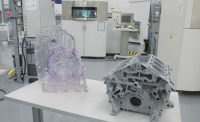Automakers View Cameras as Essential Safety Devices

Cameras are replacing side view mirrors on many cars and trucks. Illustration courtesy Continental AG
For decades, motorists have depended on side view and rearview mirrors when changing lanes or backing up. But, the good old glass mirror is slowly being replaced by cameras, sensors and display screens.
Cameras are a key component of Advanced Driver Assistance Systems (ADAS) technology that is being mandated by the National Highway Traffic Safety Administration (NHTSA). The organization recently issued a final rule requiring rear visibility technology in all new vehicles under 10,000 pounds, including buses and trucks, by the summer of 2018.
The goal is to significantly reduce the risk of fatalities and serious injuries caused by back over accidents. According to the NHTSA, those types of incidents account for an average of 210 fatalities and 15,000 injuries annually in the United States. Children under 5 years old account for 31 percent of back over fatalities each year, while adults 70 years of age and older account for 26 percent.
“The coming years will see vision systems grow even further with technologies like lane departure warning and traffic sign recognition gaining importance in many markets,” says Arunprasad Nandakumar, mobility team leader at Frost & Sullivan Inc.
Vision technology is currently available in many luxury cars, pickup trucks and sport utility vehicles. Even some mass-market cars, such as the Honda Civic and Toyota Camry, already include backup cameras as standard equipment.
Strategy Analytics Inc. predicts that automotive camera volumes will grow more than 23 percent annually between now and the end of the decade, exceeding 109 million units by 2020.
The NHTSA estimates that a full vision system will cost $132 to $142 per vehicle for the 2018 model year. That’s good news for suppliers of cameras and other vision system components, such as Bosch, Continental, Delphi, Gentex, Hella, Magna and Valeo.
“The most basic vision-based ADAS system would have a single camera mounted behind the rearview mirror,” explains Nandakumar. “There are more complex surround-view systems that use up to four cameras: two for frontal and rear view, as well as two side view cameras located on the side rear view mirrors.
“Mono cameras are currently the most preferred vision technology, primarily due to their affordability, as well as better packaging capabilities,” says Nandakumar. “But, with software, OEMs and Tier 1s are constantly improving these systems with better redundancies and validations. The algorithms that go into vision systems are highly complex, yet modular, capable of operations like object detection all the way up to lane changing, by sharing data with other sensors.
“Today, hardware is no longer the most expensive component in an ADAS vision system,” claims Nandakumar. “It is the software that goes into it. Software is currently the differentiator among various OEMs and supplies. However, software prices will become more affordable over time.”
According to most experts, the increasing use of cameras will not make final vehicle assembly more complex.
“The actual assembly is not particularly more complex,” says Ian Riches, director of the global automotive practice at Strategy Analytics. “For a front windshield-mounted camera, it just means another box being bonded to the windshield and then connected to the vehicle network, in the same way as a more traditional light sensor is today.
“What is more complex is ensuring that camera is correctly calibrated to account for any minute variations in alignment,” adds Riches. “That alignment then needs to be maintained during the vehicle’s life.”
One of the biggest technical challenges facing engineers is maintaining automotive-grade (AEC-Q100) standards, such as consistent operation across a wide temperature range (typically -40 to 105 C).
“There is also typically a requirement for a high dynamic range, so that any on-board systems can still function in challenging lighting conditions, such as low winter sun or when entering and leaving tunnels,” says Riches.
Looking for a reprint of this article?
From high-res PDFs to custom plaques, order your copy today!





